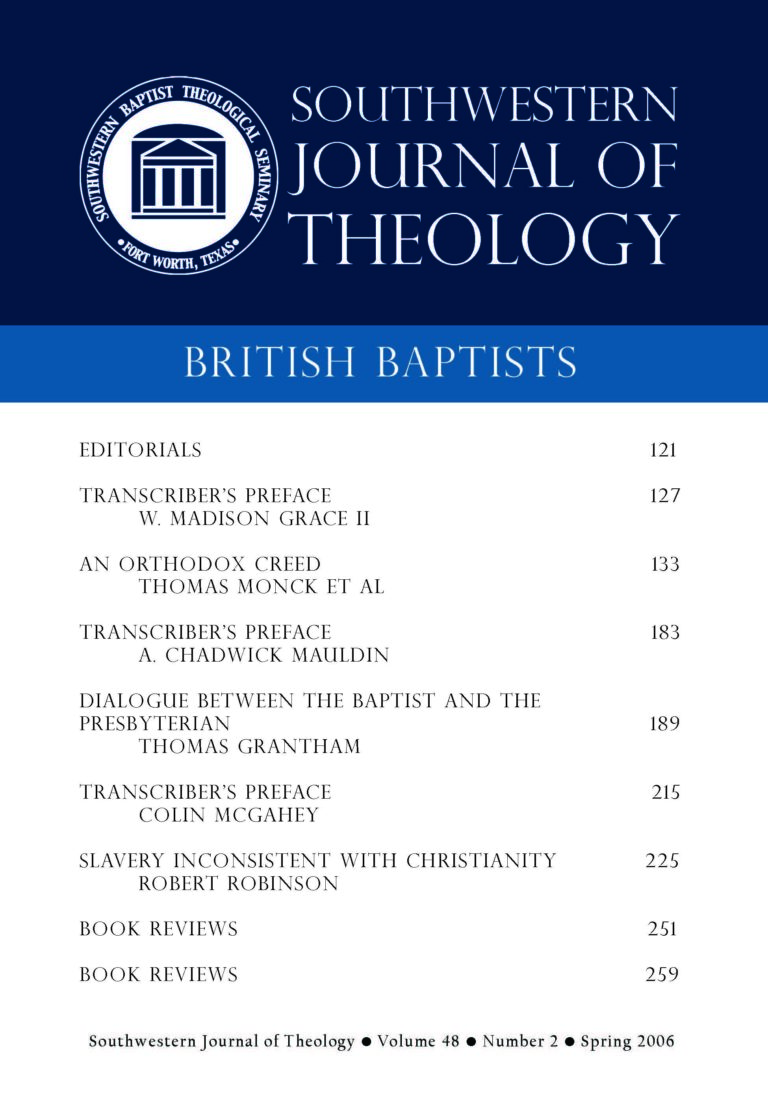
British Baptists
Southwestern Journal of Theology
Volume 48, No. 2 – Spring 2006
Managing Editor: Malcolm B. Yarnell III
By Malcolm B. Yarnell, III. Nashville: Broadman and Holman, 2007. 218 pages. Softcover, $19.99.
The study of theological method seemingly cannot be traced to Christian antiquity. That Christian theologians employed specific theological methods is clear, but theological method as a subject seems to have arisen in the modern era. Friedrich Schleiermacher’s Brief Outline on the Study of Theology (1811; rev. ed., 1830; ET, 1850, 1966) dealt more with the theological curriculum than with theological method. During the twen- tieth century theological method became a recognized discipline when Roman Catholic theologians began to write on “foundational theology” and Protestant theologians on “prolegomena.” Now a Southern Baptist theologian has produced the first Baptist contribution to this field. In do- ing so Malcolm Yarnell treats not only the method of systematic theology but also the method of historical theology.
Yarnell chooses to represent the free church/believers’ church tradition, positions himself in the mainstream of Southern Baptist theology, defines Evangelicalism as solely the theology of the magisterial Reformation, balances his full treatment of the sufficiency of Scripture with his adoption of this reviewer’s concept of suprema Scripturain place of a strict sola Scriptura, and affirms that theological method is “disciplined response to divine revelation.”
From his mainstream Southern Baptist stance the author claims that “the Reformed, Roman Catholic, and liberal theological traditions outside the Southern Baptist fold have their counterparts, respectively, in the Founders, Landmarkist, and Moderate movements within that tradition” (p. 33). He then undertakes a detailed treatment of key representatives of these three traditions: Herman Bavinck (1854–1921), Dutch Reformed, stressing grace as restoring nature and the universal church over any sec- tarianism and deemphasizing personal faith; Joseph Cardinal Ratzinger (1927–), now Pope Benedict XVI, with his “architectonic” or “centralist” ecclesiology (vs. Walter Kasper and Vatican Council II) and his tending to conflate the Church with God; and Maurice Wiles (1923–2005), Anglican liberal, theologically “hospitable,” and advocate of “doctrinal criticism.”
In contrast to these three and their alleged Southern Baptist counterparts, Yarnell then proceeds to lay out his believers’ church method by taking as his model not an early Baptist such as John Bunyan or John Gill or the Mennonites’ founder Menno Simons or Baptists’ Anabaptist hero Balthasar Hubmaier but rather the lesser known Anabaptist lay theologian Pilgram Marpeck (c. 1495–1556). Building on Gelassenheit (“yieldedness”) and Nachfolge (“discipleship”), the Southwestern professor draws from Marpeck the centrality of the divine-human Christ, the coinherence of the Word and the Spirit, the defense of “biblical order” in place of “human invention,” and the believers’ church, without any concurrent embrace of a specific philosophy.
Turning to the method of historical theology, Yarnell assesses the fifth-century definition by Vincent of Lérins of tradition (“that which has been believed everywhere, always, by all”), John Henry Newman’s developmental thesis, and Johann Adam Möhler’s organic model with the infallible magisterium, together with the recent evangelical criticisms thereof by Alister McGrath and Peter Toon, who allege denial of the sufficiency of Scripture. But does the Bible speak concerning doctrinal development? Yes, Oscar Cullmann has argued, distinguishing the transmission of the gospel (apostolic tradition) from tradition as a distinct source of authority (post-apostolic tradition). On the contrary, Yves Congar, a Roman Catho- lic, defends a more conflated view of tradition on the basis of the Paraclete sayings in the Gospel of John. Even so, Yarnell, building again on Marpeck, contends for the illumination of the Holy Spirit “for the entire church.” He is favorable to C.H. Dodd’s Christocentric Petrine and Pauline kerygma but critical of Cullmann’s view that tripartite confessions in the New Testament are liturgical but without confessional significance.
Taking serious note of the work of the English Methodist general historian Herbert Butterfield (1900–1979), who “seamlessly correlated scientific history with personal faith” (p. 161), Yarnell develops a theology of history in which Jesus is Lord of eternity as well as time, of all human beings, of providence, of both testaments, and of all the churches. Taking a close look at the work of the Southern Baptist church historian Robert Andrew Baker (1910–1992), he develops a pattern for a free church history of theology in which the golden age of the New Testament was followed by the Constantinian fall and various efforts at restitution and which is cross-centered and marked by Trinitarian revelation, personal salvation, and covenantal freedom.
A few critical comments are in order. First, the use of “free church” and “believers’ church” interchangeably is unfortunate in view of Yarnell’s penchant for detail and the multiple meanings of “free church” (non-establishment, non-creedal, non-liturgical). Second, Yarnell’s use of “Evangelicals” not only runs contrary to most contemporary usage but also can leave the impression that Baptists, Methodists, Pentecostals, and Bible Church members are non-evangelical. Moreover, this reviewer has never claimed that Evangelicalism can be traced to the sixteenth-century magisterial Reformation, partly because of its lack of the evangelistic-missionary impulse, but only to the first Great Awakening. Third, the author’s critique of any “invisible church” and lack of formulation of the “universal church” leaves open the question as to what he does with the non-local uses of ekklesia in Paul. Fourth, are not those in the minorities or “fringe movements” (p. 29) within Southern Baptist life most likely to contest Yarnell’s claim to represent the mainstream or to argue that truth outweighs numbers of adherents?
Most theologians begin their writings with articles and small mono- graphs; Yarnell’s first book is a major contribution to theological literature as well as a worthy reflection of the Southwestern Seminary heritage. It is required reading for any who consider themselves to be well informed on theological method and may indeed stimulate its discussion. This may be the most important theological monograph by a Baptist so far in the twenty-first century.





